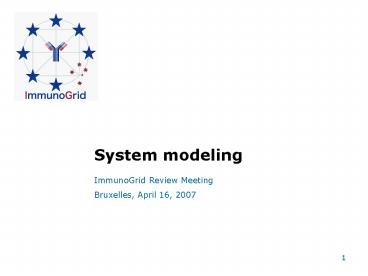System modeling - PowerPoint PPT Presentation
1 / 17
Title:
System modeling
Description:
Since at least 25 years there have been many attempts to model the immune system ... almost complete protection from mammary carcinogenesis in HER-2/neu transgenic ... – PowerPoint PPT presentation
Number of Views:19
Avg rating:3.0/5.0
Title: System modeling
1
System modeling
- ImmunoGrid Review Meeting
- Bruxelles, April 16, 2007
2
Outline
- The starting point
- Weakness of previous simulators
- From weakness to strengths with Immunogrid
consortium - The state of the Art end first year
3
The starting point
- Since at least 25 years there have been many
attempts to model the immune system at the
cellular scale. - Different maths/computational techniques have
been used. - These can be summarized in 3 hierarchical
classes - ab initio models describes individually known
entities and their interactions in space and
evolution in time. Only computational models
(cellular automata, lattice gas, agent-based
models) - Models based on integro-differential equations
describe the evolution of the distribution
functions fi(t,x,v,u) for entity i in the state
space. Maths based with numerical solutions. - Models based on ODEs describe the evolution of
the concentrations ?i(t). Maths based with
numerical solutions.
4
Our starting point
- The Celada-Seiden (type 1) model (1992) IMMSIM.
Mostly devoted to educational purpose - Revised/enhanced by F. Castiglione
- Applied to HIV by F.Castiglione et al. C-ImmSim.
Collaboration with Italian Inst. for Infectious
Disease. Reproduce AIDS disease progress - Applied to a cancer Immunoprevention Vaccine
(named Triplex) by Motta et al. SimTriplex.
Collaboration with Prof. Lollini, UniBo.
Reproduce in vivo experiments of HER2/neu
transgenic mice.
5
Weakness of previous simulators
- Model description does not use a standard
biological language - Space dimension is limited to 2D
- Models describe only one compartment (either a
lymph node or a mammary gland) - Time step is limited to 8 hours of real life
- Repertoire diversity is limited to 105 (in
practice) - Simulations usually performed on single PC
- Only used to describe existing results no
predictive results - No web access to simulators
6
First year achievements
- Model description using immuno-ontoly. CNRS
UniCT built the model ontolgy using SimTriplex as
first example - C-ImmSim space dimension expanded to 3D and
multi-organs (CNR) - Chemochines and chemotaxis included in C-ImmSim
(CNR) - Developed a lymph node model prototype (CNR)
- Solved a technical problem to expand bit-string
repertoire with no extra computational effort
(UniCT Cineca) - C-ImmSim tested on Grid (Birkbeck Coll.)
- C-ImmSim and SimTriplex available on web for
external user testing (Birkbeck Coll. CNR
UniCT) - SimTriplex used as engine for a genetic algorithm
to predict the best vaccination schedule for
Triplex vaccine (UniCT UniBO)
7
An ontology for the models
- Based on deliverable D1.1 Concepts rules by
CNRS - Describe entities and interactions in standard
terms
8
3D extension and multi organs
Time scale is parameterized to 1, 2, 4 and 8 hours
9
Chemochines and chemotaxis
Heat equation degradation term
chemochines
cells
- Explicit PDE integration scheme
- Mesh refinement
- Chemokine gradient
- 2D and 3D
10
Lymph NodePrototype
- Lymphocytes traffic is highly organized
- Spatial organization is very precise
- Specific chemokines
- Promote lymphocytes encounter and appropriate
co-stimulation
11
Preliminary testing of HPC and grid computing
- Genetic Algorithms to optimize vaccine scheduling
with SimTriplex - HPC facilities at Cineca - Genetic Algorithms to optimize HAART therapy with
C-ImmSim - HPC facilities at Cineca (wip) - Multi-individuals simulations with C-ImmSim at
Birbeck College (test cases)
12
Simulator Web access
C-ImmSim were used in Marie tutorial during BIIC
conference in Budapest (Oct 06)
13
Simulator Web access
SimTriplex soon available on-line at Birbeck
(work in progress)
14
Vaccination schedule
Triplex vaccine is an immunopreventive cellular
vaccine that combines three different signals
the specific antigen p185neu (the product of
HER-2/neu) and two non-specific signals (IL-12
and MHC I). Triplex vaccine produced an almost
complete protection from mammary carcinogenesis
in HER-2/neu transgenic female mice (De Giovanni
et al., Cancer Res. 64 4001, 2004) when
vaccination cycles (4 vaccinations over 2 weeks,
followed by 2 weeks of rest) started at 6 weeks
of age and continued for the entire duration of
the experiment, at least 1 year (CHRONIC
SCHEDULE).
15
VACCINATION PROTOCOLS
The best vaccination schedule for Triplex
vaccine protocol that minimizes the number of
vaccinations without reducing tumor prevention
efficacy in comparison to the Chronic protocol.
16
RECRUITMENT OF MICE
- Completed recruitment of 8 mice per experimental
group in Chronic, Genetic, Heuristic, Early,
ongoing for Untreated (4 mice so far) - Early vaccination protocol already concluded,
other protocols ongoing
17
Thank you































